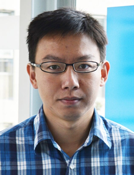2021/03/10(Wed) 15:00 -16:30 一樓演講廳 1F, Auditorium

Title
Tailoring the quantum states for topological superconductivity in hybrid material systems(視訊演講)
Tailoring the quantum states for topological superconductivity in hybrid material systems
(Video Colloquium)
Speaker
柯忠廷博士 (QuTech, Delft University of Technology, NL) Dr. Chung-Ting Ke (QuTech, Delft University of Technology, NL)Abstract
Controlling the state of quantum matter can be realized through external parameters such as pressure, magnetic field, or electric field. Another way of modifying the ground state is to combine different materials. Hybrid material systems may result in new emergent properties. An important example being superconductor/semiconductor hybrids. These have been particularly interesting in developing topological superconductivity which is the basis for creating fault-tolerant qubits. In this talk, I will discuss our work in developing topological superconductivity using hybrid semiconductor-superconductor devices.
In the first study, based on a superconductor/graphene/superconductor Josephson junctions (JJ), we reported the first observation of supercurrent in the quantum Hall regime [1]. Supercurrent transport through a quantum Hall edge is extremely difficult to observe since a high magnetic field tends to undermind the superconductivity. However, it has been predicted that such a system could host exotic quantum states such as Majorana fermion or parafermion [2]. Using ultra-clean graphene-based Josephson junction and a low noise measurement setup, we are able to detect the supercurrent mediated through quantum Hall edges. This result provides an important first step for developing topological superconductivity based on the superconductor/quantum Hall edge hybrid systems. On the other hand, using a 2D material with strong spin-orbit coupling, such as Indium Antimonide (InSb) quantum well is another approach to develop topological superconductivity. It is predicted that a large topological phase space can be realized with a planar Josephson junction [3,4]. In a Josephson junction, we demonstrated the first evidence of induced superconductivity in high-quality InSb quantum wells [5]. Furthermore, we interplay the charge density, external magnetic field, and device dimension to drive our junctions into a π phase region where the topological superconductivity is expected. This control over the free energy landscape allows us to construct a phase diagram identifying the 0 and π regions, in agreement with theory. This result establishes InSb 2DEGs as a promising new material platform to study the interplay between superconductivity, SOC, and magnetism.
[1]F. Amet*, C. T. Ke* et al., Science (80-. ). 352, 966 (2016).
[2]R. S. K. Mong et al., Phys. Rev. X 4, 1 (2014).
[3]F. Pientka et al., Phys. Rev. X 7, 021032 (2017).
[4]M. Hell, M. Leijnse, and K. Flensberg, Phys. Rev. Lett. 118, 107701 (2017).
[5]C. T. Ke*, C. Moehle* et al., Nat. Commun. 10, 3764 (2019).
CV
Download: 
Language
演講語言 (Language): in English
Hosted by